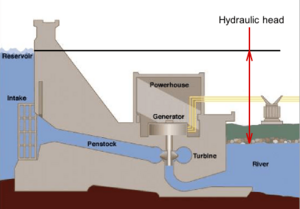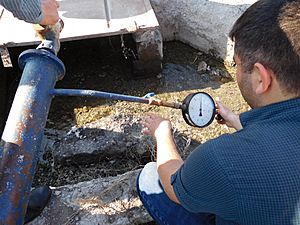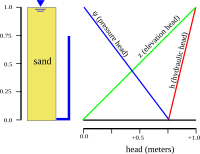Hydraulic head facts for kids


Hydraulic head (also called piezometric head) is a way to measure the "push" or energy of a liquid, usually water, at a certain point. Think of it as the height a column of water would reach if it were connected to that point. It helps us understand how water moves.
We usually measure hydraulic head as the height of the water's surface. This height is measured from a fixed reference point, like sea level. For example, in a water well, you can figure out the hydraulic head by knowing how deep the water is and the elevation of the well itself. This measurement helps scientists and engineers understand how water flows underground or in pipes.
Contents
What "Head" Means in Fluid Movement
In the world of fluid dynamics (the study of how liquids and gases move), "head" is a way to describe the total energy in a moving liquid that can't be easily squished, like water. This idea comes from Bernoulli's principle. It says that the total energy at any spot in a fluid is made up of three parts:
- The energy from the fluid's movement (like its speed).
- The energy from the static pressure inside the fluid (the pressure it exerts even when still).
- The energy from the fluid's height compared to a chosen starting point.
Head is always measured in units of length, like meters or feet. For example, if you add more fresh water height, it creates more pressure. About 9.8 kilopascals (kPa) of pressure are added for every meter of fresh water height.
A pump's static head is the highest point (or pressure) it can push water. This is useful for choosing the right pump for a job.
Some people mistakenly think head is just energy per unit of weight. But it's more complex! Head is very useful for describing centrifugal pumps because their ability to pump water doesn't really change with the water's density.
There are four main types of head:
- Velocity head: This is the energy due to the fluid's speed. The faster the water moves, the more velocity head it has.
- Elevation head: This is simply the height of the fluid above a chosen zero point. Water at a higher elevation has more potential energy, so it has more elevation head.
- Pressure head: This comes from the static pressure within the fluid. It's like the force the water pushes outwards with against its container.
- Resistance head: Also known as head loss or friction head. This is the energy lost because of friction as the fluid moves. Imagine water flowing through a pipe; the pipe's walls create friction, slowing the water down and reducing its energy.
Parts of Hydraulic Head
Imagine dropping something from a height. The faster it falls, the more energy it gains. We can turn this idea around to talk about "velocity head." This term describes the energy a fluid has because of its movement, measured as a height.
The total hydraulic head of a fluid is made up of two main parts:
- Pressure head: This is the pressure of the water, shown as the height of a water column.
- Elevation head: This is the actual height of the water above a specific reference point.
A simple way to think about the total hydraulic head is:  Where:
Where:
 is the total hydraulic head (measured in meters or feet).
is the total hydraulic head (measured in meters or feet). is the pressure head (how high the water column would go due to pressure).
is the pressure head (how high the water column would go due to pressure). is the elevation head (the actual height of the measurement point).
is the elevation head (the actual height of the measurement point).
Let's say you have a well that goes down 400 meters, and the bottom of the well is at an elevation of 1000 meters above sea level. If the water level in the well is 100 meters below the ground surface:
- The elevation of the water at the bottom of the well (
 ) would be 1000 m (ground elevation) - 400 m (well depth) = 600 m.
) would be 1000 m (ground elevation) - 400 m (well depth) = 600 m. - The pressure head (
 ) would be the height of the water column in the well, which is 400 m (well depth) - 100 m (depth to water) = 300 m.
) would be the height of the water column in the well, which is 400 m (well depth) - 100 m (depth to water) = 300 m. - So, the total hydraulic head (
 ) would be 300 m (pressure head) + 600 m (elevation head) = 900 m.
) would be 300 m (pressure head) + 600 m (elevation head) = 900 m.
The pressure head itself depends on the pressure of the water, its density, and the force of gravity.
Fresh Water Head
The density of water can change based on its temperature or how salty it is. This means that the calculated hydraulic head can be different depending on the water's density. To compare measurements from different places, scientists often convert them to a "fresh water head." This means they adjust the measurement as if the water were pure fresh water with a standard density.
Hydraulic Gradient: The Direction of Flow
The hydraulic gradient tells us the direction and steepness of the "slope" that water will flow along. Imagine a hill; water flows downhill. The hydraulic gradient is like the steepness of that hill for water.
For underground water (groundwater), this gradient shows where the water will move. It's calculated by looking at the difference in hydraulic head between two or more points and the distance between them.
 Where:
Where:
 is the hydraulic gradient (it has no units).
is the hydraulic gradient (it has no units). is the difference between two hydraulic heads (in meters or feet).
is the difference between two hydraulic heads (in meters or feet). is the distance between the two points where the heads were measured.
is the distance between the two points where the heads were measured.
Water always flows from an area of higher hydraulic head to an area of lower hydraulic head. This is like how a ball rolls downhill – energy always moves from high to low.
Hydraulic Head in Groundwater
 |
 |
Knowing the hydraulic head in an aquifer (an underground layer of rock or soil that holds water) helps us understand where groundwater will flow.
Look at the first picture: If the hydraulic head is the same everywhere, the water is still. There's no flow because there's no "slope" for the water to move down.
Now look at the second picture: If there's a difference in hydraulic head from the top to the bottom (like if water is draining away at the bottom), the water will flow downwards. This difference in head is the "hydraulic gradient" we talked about.
Atmospheric Pressure's Effect
Even though we often use "gauge pressure" (pressure measured relative to the surrounding air pressure) for hydraulic head, it's more accurate to use the total pressure (gauge pressure plus the actual atmospheric pressure). This is because the total pressure is what truly pushes groundwater around. However, it's hard to know the exact atmospheric pressure at every well over time, so this detail is often left out.
Changes in the air pressure above ground can actually affect water levels in wells. If the atmospheric pressure goes up, it pushes down more on the water in the aquifer, making the water level in the well drop slightly. Scientists have known about this effect for hundreds of years!
Head Loss: Losing Energy
When any real fluid moves, it loses energy. This happens because of friction (like water rubbing against the inside of a pipe) and turbulence (when water swirls around instead of flowing smoothly). This lost energy is called head loss.
Head loss is usually divided into two types:
- Major losses: These are energy losses that happen over the length of a pipe. The longer the pipe, the more major loss there will be.
- Minor losses: These losses happen because of things like bends, valves, or fittings in a pipe system. Even though they're called "minor," if a pipe system has many bends or valves, these losses can actually be bigger than the major losses!
Engineers use special equations and tables to estimate these head losses when designing water systems.
See also
 In Spanish: Cabezal hidráulico para niños
In Spanish: Cabezal hidráulico para niños
- Dynamic pressure
- Total dynamic head
- Stage (hydrology)
- Head (hydrology)


